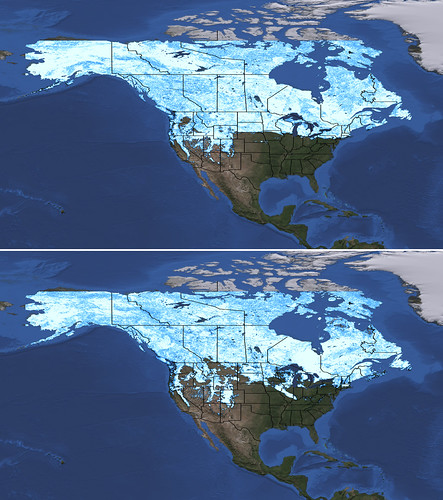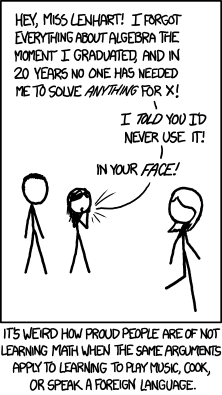I guess it must've been cloudy:
Thursday, May 31, 2012
Thursday, May 24, 2012
Restroom closed
I saw this outside the engineering building at CCNY:
I wonder how many people tried using that hole in the ground to relieve themselves before they put up those signs!
I wonder how many people tried using that hole in the ground to relieve themselves before they put up those signs!
Sunday, May 20, 2012
Seasonal variability
Below is my parking lot last year, after the snow had been melting a while. The snow is stacked in two stories.
Below is the same view of the same parking lot, the same time of year this year, just a day after our final snow.
All of that snow was gone that very week.
Here is the big picture from NASA:
Thursday, May 17, 2012
Sunday, May 13, 2012
Eye doctor form baby aching
I was in a funny mood at the eye doctor, and I thought their "Patient Health Information" section was distinctively about a lack of health. FTFY eyedoctor!
Thursday, May 10, 2012
The final flight of the Enterprise
A few weeks ago the Space Shuttle Enterprise was flown to NYC. I went out to Riverbank State Park (aka the park on top of the 140th St. sewage treatment plant) to watch it fly up
and down the Hudson.
It then flew over NJ, and back across the Hudson just south of where I was watching:
While it was no shuttle launch, it was still very cool!
and down the Hudson.
It then flew over NJ, and back across the Hudson just south of where I was watching:
While it was no shuttle launch, it was still very cool!
Monday, May 07, 2012
Pick two for your job
A wise insight noted by Matt Richardson on a fancy napkin, and then shared on this post.
Thursday, May 03, 2012
Why science literacy is important
This post is largely a followup to last week's science literacy post. First of all, here's an excellent comic from Spiked Math, posted just two short days after my rant about using any symbol you want:
Followed nicely by an xkcd comic:
And yet, it's really important to learn math! One of the regular complaints heard from pre-med students is that they're forced to take some physics (which requires math) in order to get into med school. They complain they'll "never use it" or some other similar whine. But, here's an article, published in 1994 in the journal "Diabetes Care," a high-impact, peer-reviewed journal, where the author describes an incredible new way of calculating the area under curves (which she then names after herself!):
Fortunately, many people responded to this article with nicer versions of "You moron!", but her indignant defense was, and I paraphrase, "I didn't know about this rule before, and I figured it out myself, so it's still original, and I can publish it!" While I commend her figuring it out (I really do!), original (i.e. publishable) research is not just something you figured out by yourself, it is something that no one else has figured out before! The "find out someone already did this" and "they figured this out 50 years ago" phases are an integral part of the scientific method, as described nicely in this rage comic from the Electron Cafe:
And on that note, back to my research...
Followed nicely by an xkcd comic:
And yet, it's really important to learn math! One of the regular complaints heard from pre-med students is that they're forced to take some physics (which requires math) in order to get into med school. They complain they'll "never use it" or some other similar whine. But, here's an article, published in 1994 in the journal "Diabetes Care," a high-impact, peer-reviewed journal, where the author describes an incredible new way of calculating the area under curves (which she then names after herself!):
In Tai's Model, the total area under a curve is computed by dividing the area under the curve between two designated values on the X-axis (abscissas) into small segments (rectangles and triangles) whose areas can be accurately calculated from their respective geometrical formulas. The total sum of these individual areas thus represents the total area under the curve.In other words, the so-called "trapezoid method," known well since the time of Isaac Newton, around 300 years earlier! This method is well documented in every calculus textbook out there, and yet this paper got published, and is cited (often!). While I think that having science literacy is an integral part of being a functioning member of an advanced human society, at a most basic level, a nice outcome of science literacy is that you (either as an "author" or a "reviewer") don't seem like a total moron!
Fortunately, many people responded to this article with nicer versions of "You moron!", but her indignant defense was, and I paraphrase, "I didn't know about this rule before, and I figured it out myself, so it's still original, and I can publish it!" While I commend her figuring it out (I really do!), original (i.e. publishable) research is not just something you figured out by yourself, it is something that no one else has figured out before! The "find out someone already did this" and "they figured this out 50 years ago" phases are an integral part of the scientific method, as described nicely in this rage comic from the Electron Cafe:
And on that note, back to my research...
Subscribe to:
Posts (Atom)















